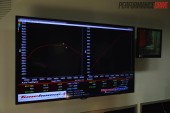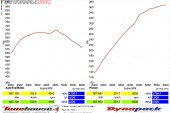How much power does the new Gen-F HSV GTS actually make at the wheels on a dyno? We’ve just put the popular mystery to bed by taking a fresh GTS Maloo over to Tunehouse in Sydney.
As we’ve discovered over the years, many performance cars don’t produce the exact power output as quoted by the manufacturer. Some vehicles produce more power than what the maker claims and others produce less.
In all honesty, we thought the new GTS and its Chev-based LSA engine produced slightly less than the 430kW written in the spec sheet. After three dyno runs using Tunehouse’s hub-type Dynapack dyno, which is regarded as the most accurate type of dynamometer, this completely stock example with around 5000km on the clock produced 368kW and 697Nm at the wheels.
Finding the output at the engine requires a lot more testing, which is what manufacturers quote. You see, the driveline – the transmission, drive shaft/s and differential – absorbs some of that power before it reaches the road. According to Tunehouse boss Jim Ghelis, the loss for a modern manual transmission vehicle is around 15 per cent.
With 430kW at the engine, minus 15 per cent (64kW), the theoretical result is 366kW at the wheels. This means the GTS does indeed produce very near 430kW from the factory. In the Maloo, it’s no wonder it is labelled as the fastest and most powerful production ute Australia has ever made.
On a side note, Tunehouse says the LSA 6.2-litre supercharged V8 engine is very easy to tune. Using the same internals and major components, the V8 can be boosted to around 440kW (at the wheels) with relatively minor modifications such as an exhaust system and computer and boost pressure adjustment.
Stay tuned for our full review and video of the GTS Maloo. We’re also putting together some details about tuning possibilities for the LSA to give you some aftermarket inspiration. In the meantime, check out the video of the dyno run below.






Hi Brett,
In your article, it is stated that the typical power loss at the wheels for modern cars with manual transmission is around 15% which is consistent with the results of the dyno. However, what you failed to mention is that for the GTS sedan, a typical RW power figure obtained on a dyno has been around 320kws or a 25% power loss. Indeed, this was the RW dyno power figure for my car and I was able to have it tuned to nearly 350kws at the RWs for a relatively small investment.
However, the questions begs…how do you explain the dramatic discrepancy between the sedan and the ute?
Regards
Hi David,
Thanks for your comment.
There are a number of different areas that influence dyno run results. Firstly, every dyno is different and you can never accurately compare one to another. Rear-wheel figures on a ‘rolling road’ dyno can change quite drastically with even the smallest of details such as different tyre pressures and how firm the car is tied down. Tyre size can also influence the result on a wheel dyno. In that case, it might be safer to account for a 18-20 per cent power loss for a manual and even higher for a rear-wheel drive auto (drivetrain load is also different for front-wheel drive cars).
Using a hub dyno ensures minimal inconsistencies. In fact, if you ran your car on the same dyno for multiple runs, chances are you would get a different reading for every run. With a hub dyno, as used above, runs are much more consistent – all three of our runs resulted in just 1-2kW variation.
In the specific example above there is a 14-15 per cent drivetrain loss according to the technician that owns/runs the dyno. It’s not really up to use to suggest any other figure for his dyno. We are simply reporting the facts that are presented to us from the specific car/dyno/weather conditions in question.
To answer your question, there is an infinite number of reasons for different results for different cars. You would need to do a back to back run with the ute and the sedan to find an accurate answer.
The main reason for our test was to see how much power the GTS actually produces. During these tests in these conditions and using Tunehouse’s calculations, this specific GTS Maloo produces around 432-433kW at the engine.
I hope this sheds some light on the situation. Who knows, if you ran your car on a hub dyno you might get more consistent results.
Cheers,
Brett
LOL- dinosaur fans and their kw’s- it’s almost as though they are making up for something!
Nice choice on the Hub dyno.
best measure of performance is the 1/4 mile, you get the trap speed and how quick its off the mark.